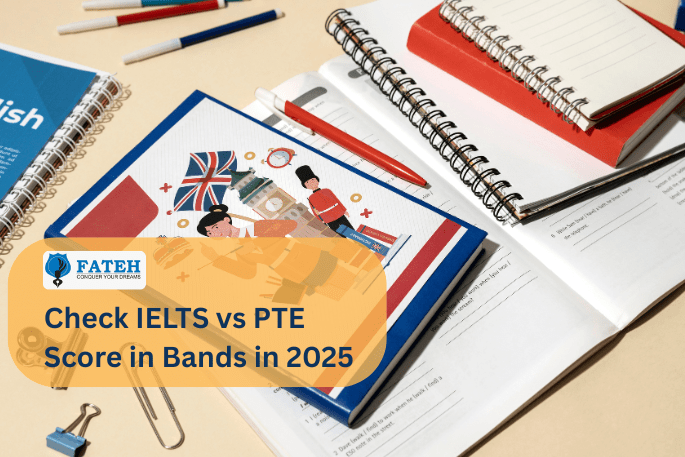Introduction
In today’s increasingly globalised education landscape, proficiency in the English language has become more than just a requirement—it is a gateway to opportunities. For many international students, securing a place in a reputed institution abroad begins with proving their English language ability through standardised tests. Among the most widely accepted are the PTE Academic (Pearson Test of English) and the IELTS (International English Language Testing System), each recognised by universities, governments and employers across the globe.
However, what happens when a student takes one test, only to find that the institution or immigration authority they are applying to requires another? This scenario is not uncommon and it is here that the need to convert PTE to IELTS scores becomes not just relevant, but essential. Whether driven by changing visa policies, shifting university requirements or simply personal preferences, students are often tasked with understanding how these two tests compare—and more importantly, how to make an informed conversion that accurately reflects their language proficiency.
In this blog, we delve deep into the nuances of score comparison between PTE-A and IELTS. We will go beyond basic conversion charts and explore the factors that influence equivalency, what students need to keep in mind and how to avoid common missteps when switching from one format to another.
Converting PTE-A scores to IELTS band scores
At first glance, converting PTE-A scores to IELTS band scores might appear straightforward—after all, both tests aim to measure English language proficiency across four core skills: Listening, Reading, Writing and Speaking. However, the reality is more complex, involving not only different scoring scales but also divergent test structures, evaluation criteria and skill-weighting mechanisms.
The PTE Academic test scores candidates on a granular scale ranging from 10 to 90, while IELTS uses a band scale of 1 to 9, with half-point increments. A direct conversion requires a nuanced understanding of how these scores correspond in real-world terms. While Pearson and IDP provide general concordance tables, these are often interpreted as fixed benchmarks, which can be misleading without context.
For instance, a PTE-A score of 65 is commonly equated to an IELTS band score of 7. However, what many students do not realise is that this equivalence assumes a uniform performance across all four skill areas.
If a candidate scores 70 in Listening and Speaking but only 60 in Writing and Reading, the final average in IELTS may not be a clear 7 band equivalent.
This variation can be crucial, especially when applying to universities that require minimum sectional scores rather than just an overall band.
Another key point to consider is that while PTE is machine-scored, IELTS includes a human element in its Speaking and Writing assessments. This introduces a layer of subjectivity in IELTS that does not exist in PTE. Thus, a student who performs well in the structured, analytical environment of PTE may find the IELTS Speaking test, with its conversational, face-to-face nature, —more challenging.
Moreover, specific linguistic competencies are emphasised differently. PTE often rewards technical accuracy and response speed, whereas IELTS leans more towards depth of understanding, coherence and natural language use. This distinction matters during score conversion, as what earns a high score in one test might not yield the same result in the other.
The bottom line? Students should take a holistic approach—reviewing individual skill scores, understanding the core differences in testing styles and even considering practice test comparisons—before drawing conclusions.
Next, we will explore how the conversion process works in greater depth, with expert-backed strategies for interpreting and utilising these score equivalents in real-world applications.
How to link PTE to IELTS band scores?
- The tables are based on median performance across large data samples, not individual cases.
- A score of 65 in PTE might represent an IELTS 7.0, but only if the candidate performs consistently across all four language skills.
- Many institutions look at both overall and sectional band requirements, so converting only the average score is not enough.
Break Down the Skills—Do Not Just Look at the Total Score
- Use this breakdown to match your PTE sub-scores (Listening, Reading, Speaking, Writing) to their IELTS equivalents.
- Check whether the target institution requires a minimum in each band. For example, some UK universities require an IELTS 6.5 overall, with no band less than 6.0.
- Review your PTE score report in detail, noting your Enabling Skills (Grammar, Fluency, Pronunciation, etc.) as they provide insight into what might affect your IELTS performance.
Simulate the IELTS Format to Test Alignment
- How well does your current skill set map onto the IELTS test style
- Whether your PTE-acquired strategies (e.g., template use in Writing or rapid automated answers in Speaking) would hold up in a more nuanced, face-to-face setting
- Where gaps might exist, particularly in Writing and Speaking, which are assessed differently in IELTS
Consult the Institution’s Own Conversion Standards
- Certain UK universities consider a PTE 65 as “equivalent” to IELTS 6.5, while others may demand a slightly higher PTE for the same band.
- Immigration authorities such as UKVI or Australian Home Affairs may apply stricter conversion interpretations when evaluating visa applications.
Use Expert Guidance to Close the Gaps
- Interpret PTE-A reports in context
- Benchmark performance accurately against IELTS
- Create a plan to improve weak areas before retesting or submitting scores
Investigating the Relationship between Pearson PTE Scores and IELTS Bands
1. Different Models, Different Outcomes
- IELTS adopts a descriptor-based model, where scores reflect observable language behaviour. For example, a Band 7 in Writing means the test taker is a “good user” who handles complex language well, despite occasional inaccuracies.
- PTE Academic, in contrast, operates on a computational model. It scores candidates through AI and automated speech/text recognition, aiming to eliminate examiner bias. The scoring is more numeric and data-driven, reflecting micro-performance in pronunciation, fluency and grammatical range.
2. Skill Testing: Isolated vs Integrated
- In IELTS, each skill—Listening, Reading, Writing and Speaking—is tested separately. This makes it easier to isolate strengths and weaknesses.
- PTE, however, often integrates skills within a single task. For instance, a Speaking item may influence both Speaking and Listening scores, creating complex interdependencies not present in IELTS.
3. A Shared Reference Point: CEFR
Official Concordance Table between IELTS and PTE
| PTE – A Score Range | IELTS Band Equivalent |
|---|---|
| 86-90 | 9.0 |
| 83–85 | 8.5 |
| 79–82 | 8.0 |
| 73–78 | 7.5 |
| 65–72 | 7.0 |
| 59–64 | 6.5 |
| 51–58 | 6.0 |
| 43–50 | 5.5 |
| 36–42 | 5.0 |
How should your organisation use the IELTS vs PTE score equivalencies
IELTS 7.0 (no sub-band less than 7.0)
This is a common benchmark for postgraduate programmes, medical registration bodies, and highly skilled migration streams. When setting this standard, it is essential to understand that a 7.0 in IELTS reflects a strong command of academic English across all four skill areas—Reading, Writing, Listening and Speaking. To mirror this in PTE:- Candidates should ideally score between 65 and 72 in each of the Communicative Skills.
- A single weak skill (e.g. Speaking at 61 while others are 70+) would not meet the IELTS 7.0 band requirement.
- Organisations should set individual PTE skill thresholds instead of relying solely on overall scores.
IELTS 6.5 (no sub-band less than 6.0)
Often, the entry requirement for undergraduate and taught master’s degrees, this threshold accommodates intermediate to upper-intermediate English speakers. To establish a fair equivalency in PTE:- Look for an overall score between 58 and 64, with no communicative skill below 50–55.
- Again, focusing only on the total score may obscure weaknesses. A candidate scoring 66 overall could still perform poorly in one section, which would not meet the IELTS 6.0 sub-band floor.
Conclusion
Navigating the path from PTE to IELTS scores is more than just a matter of number-matching—it is about understanding the deeper structure and purpose of each test. As students weigh their options or look to convert scores for university admissions, visa applications or professional licensing, clarity becomes essential. Institutions, too, have a responsibility to interpret score equivalencies thoughtfully, ensuring that language requirements reflect academic rigour as well as real-world communication demands.
FAQs on PTE to IELTS
Neither test is objectively harder—it depends on the candidate's strengths. PTE is computer-based and may suit tech-comfortable test-takers, while IELTS offers human interaction in speaking and handwritten options. PTE tasks are often more integrated, whereas IELTS keeps skills separate, which some may find easier to manage.
PTE is not inherently easy or difficult—it depends on your preparation and language ability. Since it uses automated scoring, consistency across all skills is key. Students can perform well and meet their target score with the right strategy and practice.


